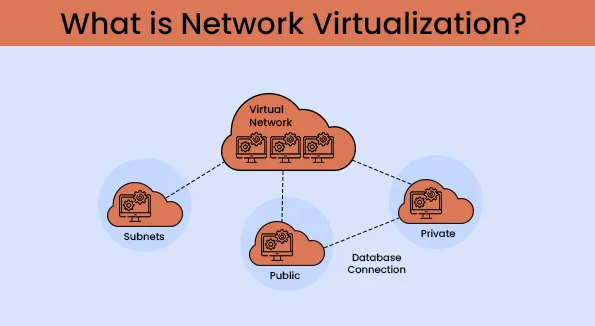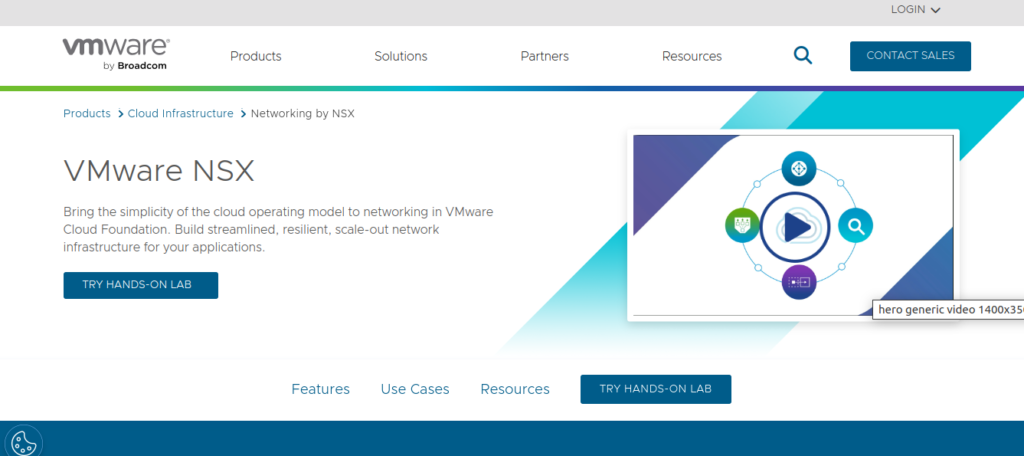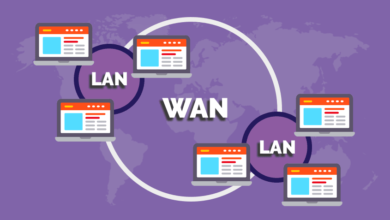What is Network Virtualization?

What if networks could evolve as rapidly as the demands placed upon them? Network virtualization makes this a reality, turning rigid, hardware-bound systems into agile, adaptable resources. In today’s digital world, where flexibility is key, network virtualization enables organizations to scale, secure, and optimize their networks with unmatched precision. Imagine having the power to manage multiple virtual networks within one physical infrastructure—creating a seamless, efficient digital environment. Ready to explore how network virtualization is revolutionizing network management and driving digital transformation?
Table of Contents
What is Network Virtualization?

Network virtualization is a sophisticated approach that transforms traditional networking by decoupling network services from physical hardware. Instead of relying solely on physical routers, switches, and firewalls, network virtualization leverages software to create multiple virtual networks within a single infrastructure. This abstraction enables administrators to dynamically allocate resources, scale networks on demand, and streamline management with ease. The virtualized environment fosters agility and efficiency, allowing businesses to deploy and reconfigure applications without being constrained by physical limitations. By embracing network virtualization, organizations can enhance security, improve performance, and reduce costs—unlocking the true potential of their network infrastructure.
How Does Network Virtualization Work?
- Abstract Physical Resources: Network virtualization starts by decoupling network functions from physical devices (routers, switches, etc.). This abstraction layer allows multiple virtual networks to operate within a single physical network infrastructure.
- Separate Control and Data Planes: The network is divided into two main planes:
- Control Plane: Managed by a centralized controller, it makes decisions about data routing and policies.
- Data Plane: Manages the actual data flow based on instructions from the control plane.
- Create Virtual Network Functions (VNFs): Software replaces traditional hardware-specific functions, enabling tasks like routing, firewalls, and load balancing to occur virtually, enhancing flexibility and scalability.
- Configure Segmentation and Isolation: Virtual networks are divided into isolated segments. Each segment can have its own access controls and rules, strengthening security and allowing more precise traffic management.
- Dynamic Resource Allocation: Network resources, such as bandwidth or storage, can be allocated in real-time to meet specific needs. This agility allows the network to adapt quickly to changes without physical adjustments.
- Continuous Monitoring and Adjustment: Network virtualization allows ongoing oversight and adjustments. The centralized controller can quickly alter settings, enforce security protocols, or reconfigure network paths, optimizing network performance and resource use.
In the era of digital transformation, network virtualization is not just an option but a necessity for organizations seeking agility and scalability in their operations.
Why is Network Virtualization Important?
- Agility and Scalability: Network virtualization allows organizations to deploy applications quickly and adapt to changing workloads without requiring physical alterations to the network infrastructure.
- Dynamic Resource Management: By abstracting network resources, network virtualization enables efficient allocation and reallocation of bandwidth and computing resources, ensuring optimal performance based on real-time demands.
- Enhanced Security: Virtual networks can be segmented, providing isolation for sensitive data and allowing for more granular control over access permissions, which strengthens overall network security.
- Cost Efficiency: With network virtualization, the reliance on physical hardware is significantly reduced, leading to lower capital expenses and operational costs associated with maintenance and upgrades.
- Simplified Management: Centralized control over virtual networks streamlines management tasks, enabling IT teams to implement changes and enforce policies with minimal disruption.
- Future-Ready Infrastructure: As businesses face rapidly evolving technological landscapes, network virtualization provides a robust foundation that can adapt and scale to meet future demands and challenges.
Types of Virtual Networks
| Type of Virtual Network | Description |
| Virtual Local Area Networks (VLANs) | VLANs segment a physical network into multiple logical networks, allowing organizations to group devices based on functional or departmental needs rather than their physical location. This isolation enhances security by restricting broadcast traffic and minimizes congestion on the network. VLANs enable easier management and improved performance, especially in large enterprises. Administrators can implement access controls to ensure that sensitive data remains within specific VLANs, protecting it from unauthorized access. |
| Virtual Private Networks (VPNs) | VPNs establish secure, encrypted connections over public or shared networks, providing remote users with safe access to internal networks. This is crucial for businesses with remote workforces, as it ensures that sensitive data transmitted over the internet is protected from eavesdropping and tampering. VPNs can use various protocols, such as IPsec or SSL, to encrypt data, and they often include features like authentication and tunneling to enhance security. They play a pivotal role in maintaining confidentiality and integrity in communication. |
| Overlay Networks | Overlay networks function on top of existing physical infrastructure by creating virtual connections that allow for more flexible networking solutions. Using tunneling protocols such as GRE or VXLAN, they can facilitate the creation of isolated networks that operate independently of the underlying hardware. This is particularly beneficial in cloud environments and multi-tenant architectures, where different organizations can coexist on the same physical infrastructure without interference, enabling efficient resource utilization and management. |
| Software-Defined Networks (SDNs) | SDNs revolutionize network management by separating the control plane, which makes decisions about how traffic should flow, from the data plane, which forwards that traffic. This separation enables centralized control, allowing administrators to manage and configure network resources programmatically through a central controller. SDNs enhance flexibility, as changes can be made quickly and consistently across the network, supporting the deployment of new applications and services without needing extensive physical reconfiguration. |
| Virtual Network Functions (VNFs) | VNFs replace traditional, hardware-based network functions with software-based alternatives, facilitating the deployment of services such as firewalls, load balancers, and intrusion detection systems within a virtualized environment. This transition reduces reliance on physical hardware, lowers operational costs, and accelerates service deployment. VNFs can be managed centrally, allowing for quick scaling and adaptation to changing traffic patterns or security threats, thereby increasing overall network efficiency and responsiveness. |
| Multi-Protocol Label Switching (MPLS) | MPLS enhances the speed and efficiency of network traffic flows by using labels to make data forwarding decisions. Instead of relying solely on traditional IP routing, MPLS directs data along predetermined paths based on the labels assigned to packets. This approach allows for better bandwidth management, reduced latency, and improved quality of service (QoS) for different types of traffic. MPLS is often used in enterprise networks and service provider environments to support various applications, including voice, video, and data services. |
Network Virtualization and Cloud Computing
Network virtualization is a cornerstone of cloud computing, fundamentally transforming how organizations manage and deploy their IT resources. By abstracting physical networks into flexible, software-defined architectures, network virtualization allows for the dynamic allocation of resources, enabling businesses to scale their operations with unprecedented agility. This synergy between network virtualization and cloud computing means that organizations can provision virtual networks on-demand, facilitating rapid deployment of applications and services.
Moreover, network virtualization enhances security and isolation within cloud environments, allowing multiple tenants to share the same physical infrastructure without compromising data integrity. It simplifies network management, providing centralized control over configurations and policies, which is essential for maintaining compliance in complex cloud environments. As enterprises increasingly migrate to the cloud, the integration of network virtualization not only optimizes performance but also fortifies the infrastructure against evolving cyber threats, ensuring that businesses remain resilient and competitive in the digital age.
Network virtualization allows businesses to transcend the limitations of traditional networking, enabling seamless resource allocation and enhanced security across dynamic environments.
Benefits of Network Virtualization
- Enhanced Agility: Network virtualization enables rapid deployment and reconfiguration of network resources, allowing organizations to quickly respond to changing business needs and technological advancements.
- Cost Efficiency: By reducing reliance on physical hardware, network virtualization lowers capital and operational expenses. Organizations can maximize resource utilization, minimizing waste and cutting costs associated with maintenance and upgrades.
- Improved Scalability: Virtualized networks can be easily scaled up or down to accommodate fluctuating workloads. This flexibility allows businesses to efficiently manage resources without significant delays or disruptions.
- Simplified Management: Centralized control over virtual networks streamlines management tasks. Administrators can implement policies, configurations, and monitoring from a single interface, enhancing overall operational efficiency.
- Enhanced Security: Network virtualization allows for the segmentation of networks, isolating sensitive data and enabling tailored security policies for different virtual segments. This granular approach enhances overall security and minimizes risks.
- Increased Performance: By optimizing resource allocation and reducing network congestion, network virtualization can improve overall performance. Traffic can be prioritized based on application requirements, ensuring that critical services receive the necessary bandwidth.
- Support for Multi-Tenancy: Network virtualization facilitates the coexistence of multiple users or tenants within the same physical infrastructure. This capability is essential for service providers and enterprises operating in multi-tenant environments, ensuring that each tenant’s data and applications remain isolated and secure.
- Disaster Recovery and Business Continuity: Virtual networks can be quickly backed up and restored, enhancing disaster recovery strategies. In the event of a failure, organizations can rapidly recover their network configurations and services, ensuring minimal downtime and continuity of operations.
- Integration with Cloud Services: Network virtualization aligns seamlessly with cloud computing, enabling organizations to leverage cloud resources efficiently. This integration supports hybrid cloud architectures, allowing for optimized resource distribution between on-premises and cloud environments.
- Future-Proof Infrastructure: By adopting network virtualization, organizations can build a more adaptable and resilient infrastructure that can evolve alongside emerging technologies and changing market demands. This forward-thinking approach positions businesses for long-term success in an ever-evolving digital landscape.
Challenges of Network Virtualization
- Implementation Complexity: Transitioning to network virtualization involves a complex integration process that requires thorough planning, skilled personnel, and often significant changes to existing infrastructure. Organizations may face difficulties in mapping out the new architecture and ensuring compatibility with legacy systems.
- Performance Overhead: While network virtualization aims to improve resource utilization, it can also introduce performance overhead. Virtualized environments may experience latency issues if the underlying hardware and software are not optimally configured, potentially impacting the speed and efficiency of critical applications.
- Monitoring and Visibility: Traditional network monitoring tools may struggle to provide adequate visibility into virtualized environments. This lack of insight can hinder troubleshooting efforts and complicate performance management, making it challenging to maintain operational efficiency.
- Security Risks: The abstraction of resources in network virtualization can create new security vulnerabilities. If not properly segmented and managed, virtual networks may expose organizations to unauthorized access or data breaches. Implementing robust security measures becomes crucial to protect sensitive data.
- Skill Gaps: Adopting network virtualization often requires new skill sets and expertise that may not be readily available within an organization. Ongoing training and development are necessary to equip IT teams with the knowledge to effectively manage and optimize virtualized networks.
- Resource Allocation Issues: Improperly configured virtual networks can lead to inefficient resource allocation, where some applications may consume disproportionate amounts of bandwidth or processing power. This imbalance can degrade overall network performance and hinder application responsiveness.
- Compliance and Governance: Ensuring compliance with regulatory standards in a virtualized environment can be challenging. Organizations must implement comprehensive governance policies to manage data privacy and security while navigating the complexities of virtualized architectures.
- Vendor Lock-In: Relying on specific vendors for network virtualization solutions may result in vendor lock-in, limiting flexibility and potentially increasing costs over time. Organizations must carefully evaluate solutions to ensure they can adapt to changing needs without becoming overly dependent on a single provider.
- Integration with Legacy Systems: Integrating network virtualization with existing legacy systems can present compatibility challenges. Organizations must ensure that new virtualized environments can effectively communicate and operate alongside older technologies to avoid disruptions.
- High Initial Costs: Although network virtualization can reduce long-term operational costs, the initial investment in technology, training, and transition can be substantial. Organizations may face financial hurdles when attempting to adopt and implement these advanced solutions.
Examples of Virtual Networks
1- Amazon Web Services (AWS)

Amazon Web Services (AWS) stands as a titan in the realm of cloud computing, providing an extensive suite of services that empower businesses to harness the power of technology. With its robust offerings, AWS facilitates network virtualization, enabling organizations to create flexible, scalable network architectures that meet their evolving needs. From computing power and storage solutions to advanced networking capabilities, AWS allows enterprises to innovate rapidly while maintaining control over their digital environments. The platform’s commitment to security and compliance ensures that organizations can operate confidently, leveraging the full potential of network virtualization to enhance operational efficiency and agility in an increasingly competitive landscape.
2- Microsoft Azure Virtual Networks

Microsoft Azure Virtual Networks provide a powerful framework for network virtualization, enabling organizations to create isolated, secure environments in the cloud. Through Azure’s extensive suite of networking services, businesses can easily extend their on-premises networks into the cloud, facilitating seamless communication between resources. This capability empowers users to implement robust network security measures, establish custom IP address ranges, and configure routing rules to optimize data flow. Azure Virtual Networks also support the integration of other Azure services, allowing for dynamic scaling and enhanced operational flexibility. By leveraging network virtualization in Azure, organizations can accelerate their digital transformation while maintaining control over their network architectures.
3- VMware NSX

VMware NSX revolutionizes the way organizations approach network virtualization, providing a comprehensive platform for managing virtual networks across multi-cloud environments. By abstracting network services from the underlying hardware, NSX enables businesses to create, manage, and secure virtual networks with unparalleled agility. Users can deploy advanced networking features such as micro-segmentation, load balancing, and automated provisioning, all while enhancing security through policy-driven controls. This flexibility allows enterprises to adapt their network architectures in real-time, ensuring optimal performance and reliability. As organizations embrace digital transformation, VMware NSX stands out as a critical tool for leveraging network virtualization to drive innovation and operational efficiency.
Network Virtualization and Software-Defined Networking
Network virtualization and Software-Defined Networking (SDN) represent a paradigm shift in how networks are designed and managed, offering unprecedented flexibility and efficiency. Network virtualization abstracts the physical infrastructure, allowing multiple virtual networks to coexist on a single physical network. This enables organizations to allocate resources dynamically, responding swiftly to changing demands.
In tandem, SDN decouples the control plane from the data plane, providing centralized management and programmability of the network. By leveraging SDN, organizations can automate network configurations, optimize traffic flows, and implement real-time policy changes, enhancing overall performance. The integration of network virtualization with SDN allows for seamless orchestration, enabling businesses to deploy applications rapidly while ensuring robust security and compliance measures.
Together, these technologies empower enterprises to innovate at an accelerated pace, enhancing operational agility and reducing costs. As digital transformation continues to reshape industries, the synergy between network virtualization and SDN is pivotal in building resilient and scalable network architectures.
Conclusion
In summary, network virtualization emerges as a transformative force within the modern IT landscape, driving innovation and operational efficiency. By abstracting physical resources, it empowers organizations to create flexible, scalable networks that can adapt to ever-changing business needs. The integration of network virtualization with complementary technologies like Software-Defined Networking enhances management capabilities and optimizes resource allocation. While challenges exist, the benefits far outweigh the obstacles, positioning network virtualization as a critical component in achieving a resilient and agile infrastructure. As businesses continue to evolve, embracing network virtualization will be essential for navigating the complexities of digital transformation and ensuring competitive advantage in a rapidly advancing technological world.
Embracing network virtualization empowers companies to innovate faster, optimize their IT infrastructure, and respond swiftly to market demands in a constantly evolving landscape.
FAQ on Network Virtualization
- What is network virtualization?
- Network virtualization is the process of abstracting physical networking resources to create virtual networks that can be managed and deployed independently.
- How does network virtualization work?
- Network virtualization operates by separating the network control layer from the physical infrastructure, allowing for dynamic resource allocation and management through software.
- What are the benefits of network virtualization?
- The benefits of network virtualization include enhanced scalability, cost efficiency, improved security, and simplified management of network resources.
- What challenges are associated with network virtualization?
- Challenges of network virtualization may include implementation complexity, performance overhead, and ensuring adequate security measures to protect virtualized environments.
- How does network virtualization relate to Software-Defined Networking (SDN)?
- Network virtualization complements Software-Defined Networking (SDN) by allowing for centralized control and management of virtual networks, enhancing agility and operational efficiency.
- What industries benefit the most from network virtualization?
- Industries such as telecommunications, cloud computing, and enterprise IT significantly benefit from network virtualization, leveraging it to enhance service delivery and operational capabilities.
- Can network virtualization improve disaster recovery?
- Yes, network virtualization can streamline disaster recovery processes by enabling rapid backups and the restoration of network configurations, ensuring business continuity.
- How does network virtualization support cloud computing?
- Network virtualization enhances cloud computing by enabling flexible resource allocation, improving security through segmentation, and facilitating the seamless integration of on-premises and cloud resources.




